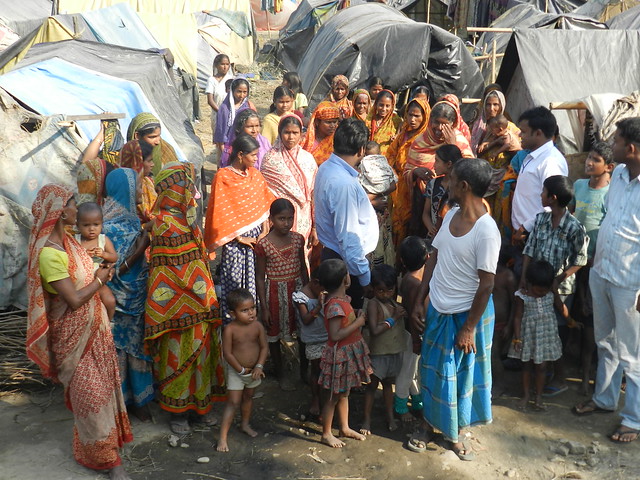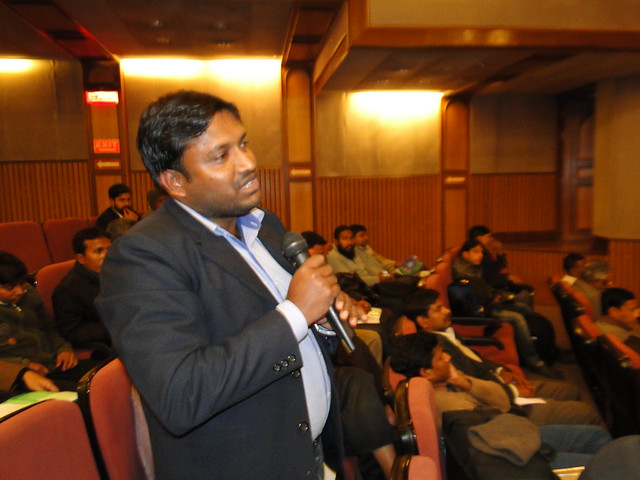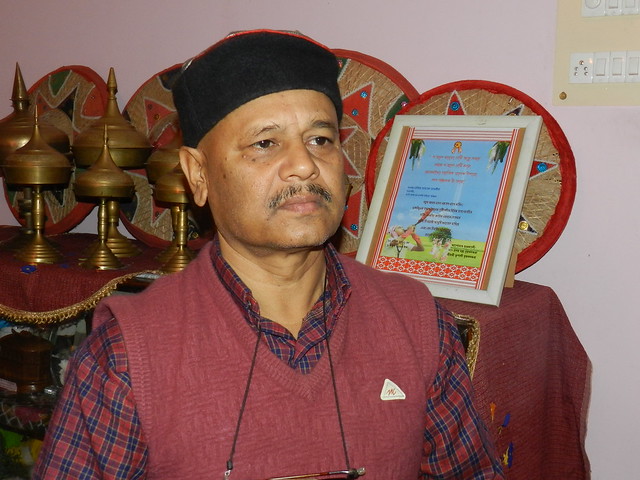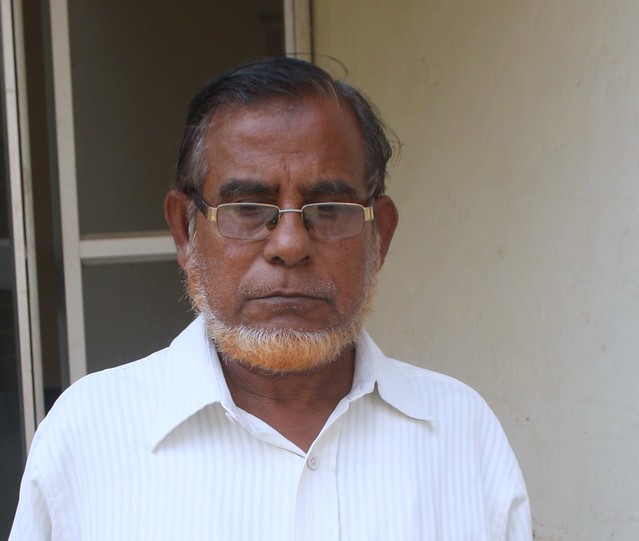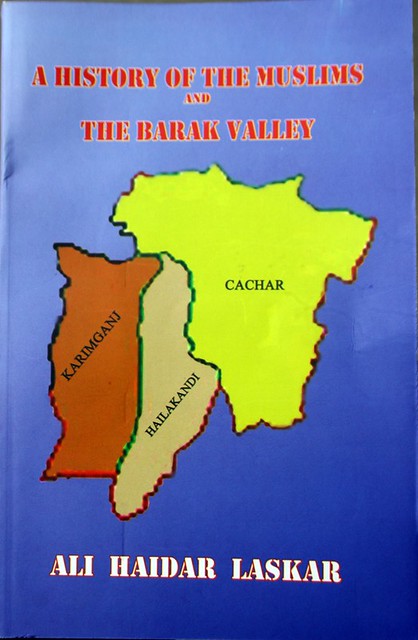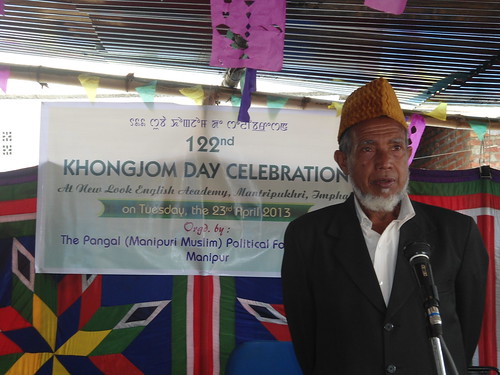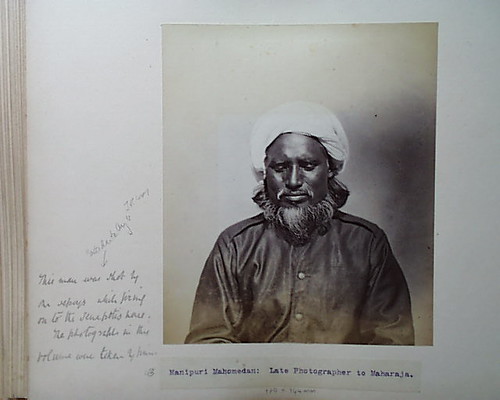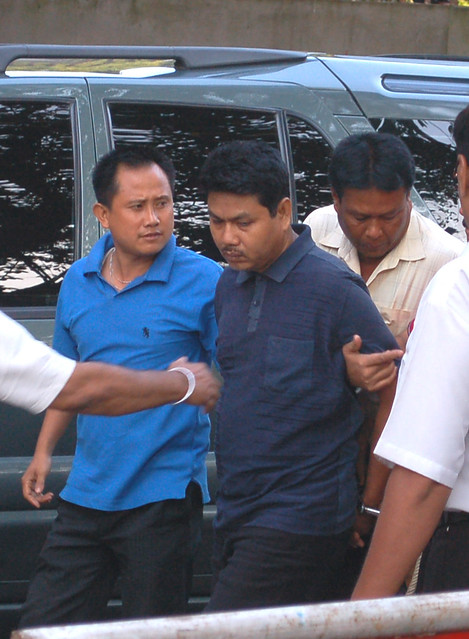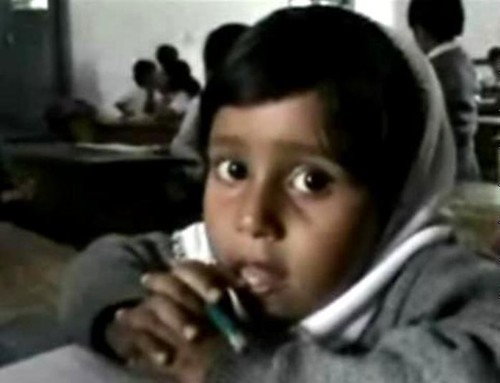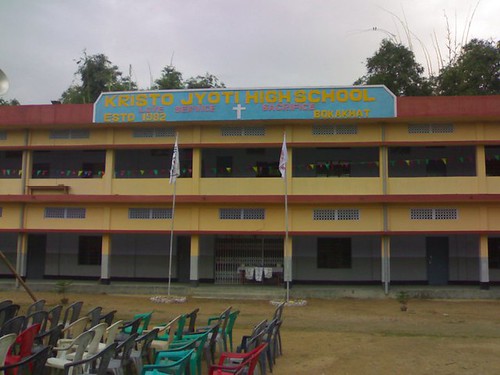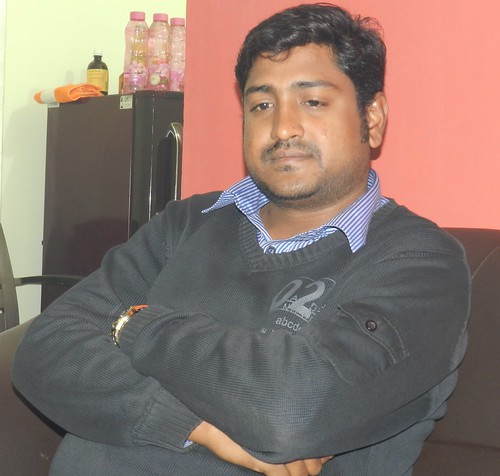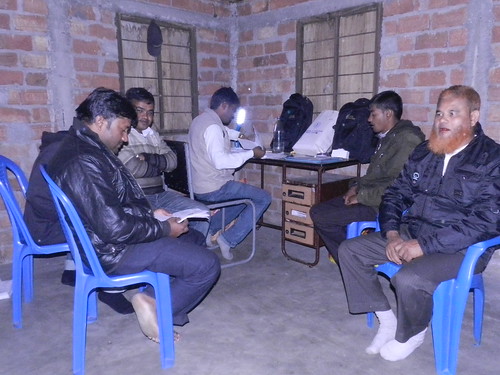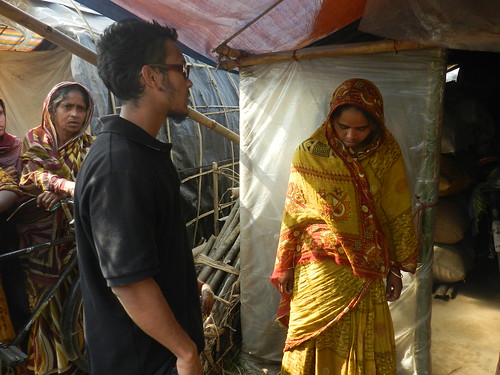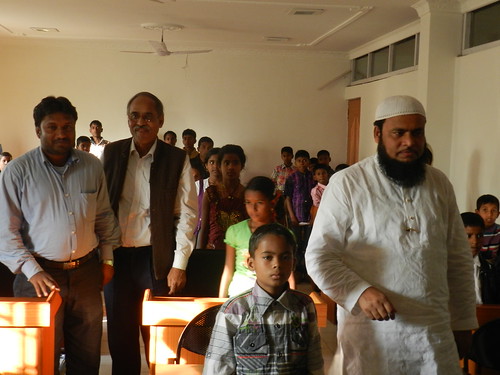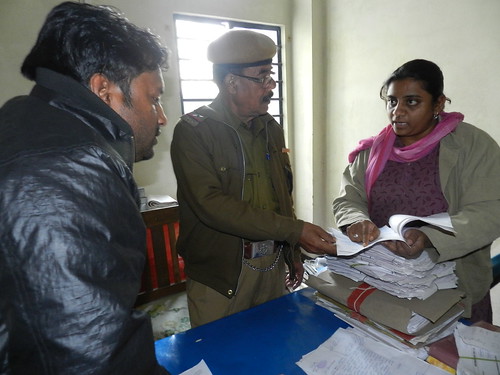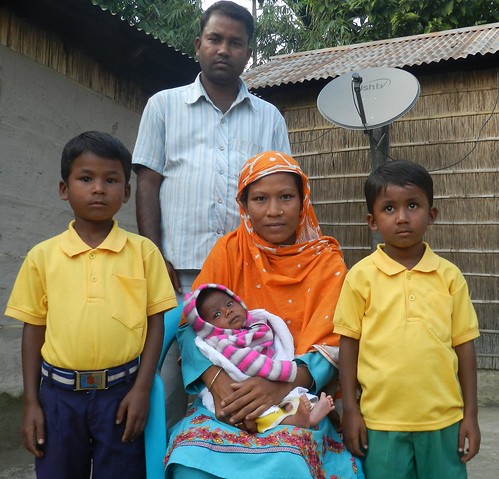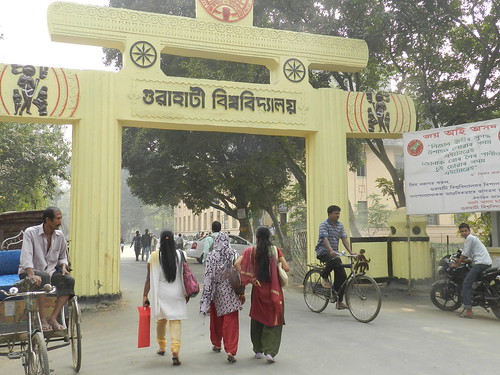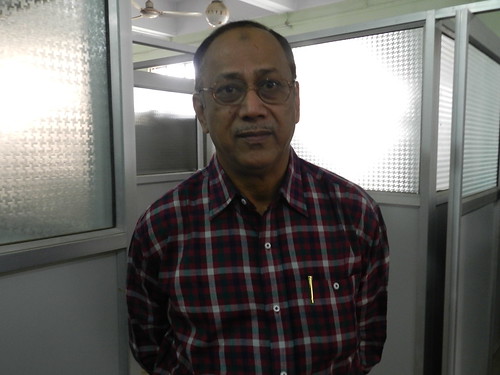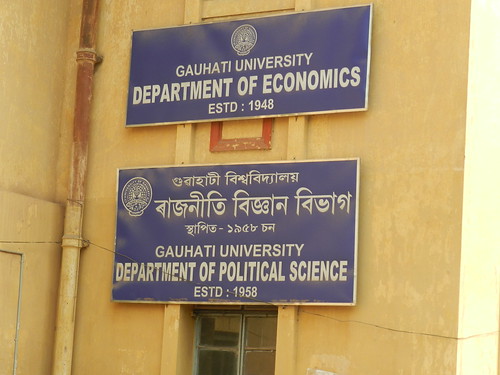Over four months have passed since violence broke out in the Bodoland Territorial Area District (BTAD) in July 2012. In this special series on Bodoland violance, we bring stories of violence, desperation, and also hope from this "tinderbox." This series has been made possible with financial support from Indian Muslim Relief Committee (IMRC).
By M. Reyaz, TwoCircles.net,
Over the years the meta narrative in the country about origins of Muslims in Assam is filled with unidirectional flow of information that want us to believe that Muslims – or at least Bengali speaking Muslims – are all of ‘foreign’ origin, having come from Bangladesh. Many such people (election Commissioner H. S. Brahma) emphasised on the fact that it’s not Hindu-Muslim issue but of Indian vs foreigners. It’s a different matter that people – and ideology that championed such causes - are the same group of people who would not hesitate to label all Indian Muslims of ‘foreign origin.’
There have been very few sane voices that tried to put the whole issue in perspective. Nilim Dutta was one such voice that bravely stood and regarded the whole Bangladeshi issue as “myth.” He also briefly mentioned about origins of Muslims in the current state of Assam and focused particularly on the several census data to prove his point that there has been no significant ‘illegal’ migration.
This article attempts to sketch the history of Muslims in Assam and in that light also tries to see the present situation.
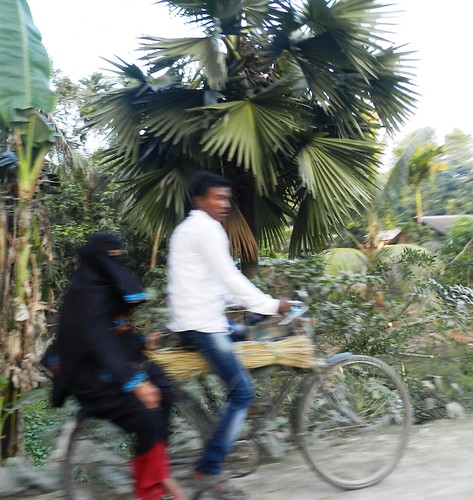
Muslim migration to Assam began in the 12th and 13th Century.
Medieval Assam (Kamrupa): Kamrupa kingdom had trade contacts with Chinese, Turks and Central Asian region even before the advent of Muslims. Many darvesh, sufi, fakirs and pir are believed to have come to the region as early as 11th and 12th century.
The first trace of Muslims settlement in what is today Assam is found towards the end of the 12th century when in 1198 a Turkish army led by Muhammad ibn Bakhtiyar Khilji conquered Bengal, that comprised parts of western Kamrup (old Assam). However, the first so called invasion by Muslim ruler/general in 1202 failed as most of Bakhtiyar Khilji’s soldiers died due to unfavorable climate.
Although Turkish army was defeated, some of the surviving soldiers stayed back and settled there, rather than going with their defeated general. They married local Assamese girls and gradually integrated with the local population.
Parts of Western Kamrupa – that is most of southern parts of erstwhile districts of Kamrup and Goalpara for long remained under the authority of Gauda Sultan, even as Ahom kings were now ruling eastern parts of Assam. However, from historical records one can say that the two neighbouring states had trade and commerce relations and hence gradually some Muslim traders and artisans settled in parts of western Assam.
In the sixteenth century, however, Ahom rulers wrested back Kamrup from the Gauda Sultan. Historical records suggest that Muslims settlers lived in harmony with the local population under Ahom kings.

Rajdhani mosque, Guwahati.
In 1530, after the army of Turbak was defeated by the Ahom king Suhungmung, Muslim prisoners of war were settled in different parts of the state. They were perhaps the earliest Muslim settlers in eastern Assam and came to be known asMoriya.
Major portion of Western Assam, in fact, was under Muslim Nawabs by the 17th century with courts at Rangamati and Hajo (Kamrupa). Mukarram Khan, the Governor of the newly acquired Koch-Hajo brought over 10,000 infantry under several Muslim nobles to consolidate his hold. These soldiers gradually settled in the region.
Erstwhile Kamrupa and Goalpara districts were at the ‘fault line’ between the Mughal Empaire and the Ahom kingdom and consequently saw intermittent conflicts between two camps from 1614-1682 when it changed hands several times. In 1682, after several losing scuffles the Mughal army under Nawab Mansur Khan vacated Kamrup. This marked the end of ‘Muslim invasions’ in Assam.
Assamese take pride in the fact that although several Muslim generals/governors tried invading Assam at least 19 times, they could never succeed in establishing permanent hold in the region, except for a brief period of about ten months during 1662-63 when Mir Jumla controlled the Ahom capital.
However, they were successful in establishing considerable influence in the border districts along western limits. Persian writings of the period chronicles that the descendents of Musalmans who had settled in Assam ‘act exactly in manner of the Assamese, and have nothing of Islam except the name.’
Amongs the Sufi saints who came and settled in Assam Shah Milan, popularly known as Azan Fakir deserve special mention. His zikirs or devotional songs are sung even today. Many Muslim preachers are known to have got generous grants and financial support from the Ahom rulers and the general condition was not hostile to the Islamic faith in general or Muslims in particular.
Like other parts of the country, many lower caste Hindus converted to Islam, but they still retained their social norms or modes of interactions within or outside the community. Many continued with their profession.
In Assam one can still find many “split families,” where some relatives are still Hindus, while others converted to Islam. In November 1821, when Burmese army attacked western Assam, many people who fled took shelter at Muslim houses. However, when they came back after peace was restored, they were not accepted in the Hindu fold because of their ‘close contacts and inter-dinning’ with Muslims and were hence left with no option, but accept Islam.
A large number of Muslim artisans and craftsmen with skills in tailoring, embroidery, wood carving, engraving, etc. were invited or appointed in various related departments by Ahom rulers. Besides Nawab Deka, some Uzirs, there were someMusalmaan Dewans who were given grants and tract of revenue free lands. Many Boras, Saikias, Hazarika and even Baruas were also appointed from amongst the Muslims by Ahom rulers.
In fact there are instance when Muslims and Hindus of Assam together fought the ‘Muslim invaders.’ Rupai Goriya, Bagh Hazarika, Sardar Julfikar Barua alias Bahadur Gaonburha, Shah Hussain Khan and Shah Ramzan Khan are some of the names worth mentioning, who showcased exceptional valour in their fights against the Mughals.
Ismail Siddique, popularly known as Bagh Hazarika as he unarmed killed the tiger and earned the title of Hazarika from Ahmom king for his valour, was a highly skilled front ranking military officer. He fought and commanded operations against Mughal’s attack on Ahom kingdom.
Consequently, number of Muslims in the state significantly rose. While the 1871 census reported their number in the state to be 176,109 in 1881 they rose to 204,344. What is crucial to note is that the Goalpara and Kamrup districts formed the bulk of population from the beginning. While in 1872 the Muslim populations in two districts were respectively 89,916 and 45,823, by 1881 it had risen to 102, 2773 and 50,305.
British Period: As the Ahom kings became weak Burmese territorial ambitions extended beyond Arakan to today’s Assam, Manipur, etc. Britian was drawn into what came to be known as the first of the three Anglo-Burmese wars that eventually resulted in the victory of the East India Company. After the war (1824–1826), Burma was forced to pay huge war indemnity, besides ceding territories gained in Assam, Manipur, etc. by the treaty of Yandabo (1826). Thus Assam became part of the British East India Company. The final subjugation, however, was achieved only after 1858.
In their aim to increase the agriculture production of the region, the British government encouraged large scale migration of hard working Muslim peasants from East Bengal (present Bangladesh), most of whom settled in em>chars or river basins. Thus in the first quarter of 20th century substantial number of Muslim peasants migrated and settled to Assam, particularly in the bordering district of erstwhile Goalpara and Kamrup. According to 1921 census, about 2, 58,000 Bengali Muslims cultivators migrated to Assam from East Bengal, particularly from Mymensing, Rangpur, Pabna and Bogra. In fact, the zamindars of Goalpara too had encouraged hard working labour migrations from East Bengal.
The White Paper brought out by the current state government after the July conflict in October, 2012 too recognizes the “positive and beneficial effects of migration of the peasants from East Bengal.” It further adds: “The peasant migrants from the erstwhile East Bengal brought with them superior cultivation techniques including multiple cropping and introduced poultry farming. Because of the agricultural practices of the hardworking immigrants and their contribution to the agricultural economy, rice production increased significantly. A number of vegetables and crops including jute hitherto unknown in the state were also introduced by the migrants” (P. 5).
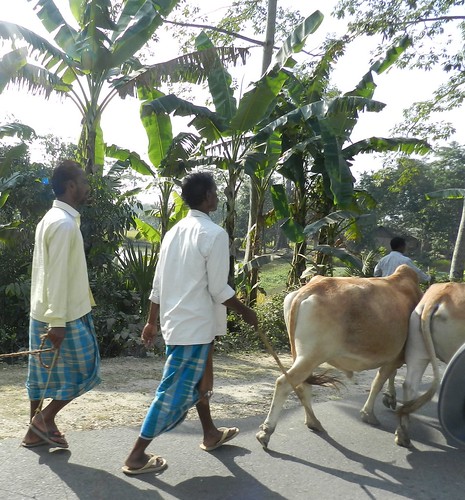
In their aim to increase the agriculture production of the region, the British government encouraged large scale migration of hard working Muslim peasants from East Bengal (present Bangladesh), most of whom settled in chars or river basins. Most of them settled in the erstwhile Goalpara district.
Moreover, till 1874 when a separate province of Assam was created, the region remained part of the Bengal Presidency. At the time of its creation the thickly Muslim populated district of Sylhet (at the time of partition it became part of East Pakistan (present Bangladesh) following a referendum) was also incorporated into Assam. Naturally a large number of Bengali Hindus and Muslims migrated to other parts of the state in search of better opportunities. Most of them settled in Barak valley.
Independence: Because of unsettled conditions and porous border, as also the historical pattern of migration, influx of Bengalis – both Hindus and Muslims - from erstwhile East Pakistan did occur. According to the recent White Paper, initial number of such migration was somewhere between 1, 50,000 and 2, 00,000, but later estimate puts it to be around 5,00,000. In his report on the 1961 census, the Registrar General of Census had put the number of ‘infiltrants’ to 2, 20,691. What is interesting to note is that during “1961-1966 approximately, 1,78,952 infiltrants were either deported or had voluntarily left the country,” the White Paper acknowledges. The influx had considerably risen once again during the 1971 war that comprised of both Bengali Hindus and Muslims.
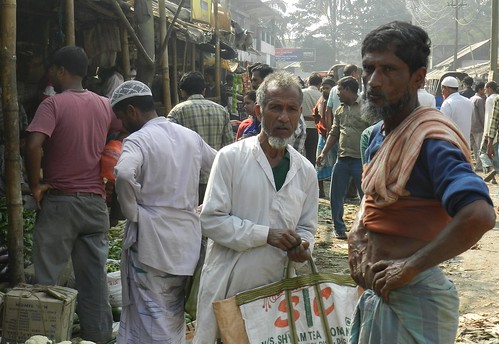
They gradually shifted to other districts as well.
Religion-wise Population of Assam since 1991
(Based on Census Data)
Figures in bracket show the percent age of total population
|
Hindus
|
Muslims
|
Others
|
1901
|
2183922 (71.03)
|
381344 (12.40)
|
509404 (16.57)
|
1011
|
2685136 (67.95)
|
659611 (16.69)
|
606736 (15.36)
|
1921
|
3160357 (67.33)
|
911179 (19.41)
|
622630 (13.26)
|
1931
|
3936431 (70.09)
|
1314700 (23.41)
|
364584 (6.50)
|
1941
|
3185823 (46.84)
|
1739235 (25.72)
|
1858216 (27.44)
|
1951
|
5781974 (72.01)
|
1981867 (24.68)
|
265015 (3.31)
|
1961
|
7730696 (71.33)
|
2737287 (25.26)
|
369337 (3.41)
|
1971
|
10604618 (72.51)
|
3592125 (24.56)
|
431787 (2.93)
|
1991
|
15041353 (67.13)
|
6373195 (28.43)
|
999774 (4.44)
|
2001
|
17296455 (64.89)
|
8240617 (30.92)
|
1118526 (4.19)
|
The Assam Accord, signed on August 15, 1985, at the behest of then Prime Minister Rajiv Gandhi between Assam Students Union (AASU), Government of India and Government of Assam, has settled March 24, 1971 as the “cutoff date for identification and deportation of immigrants.”
The Citizenship Act (1955) has ‘Special provisions as to citizenship of persons covered by the Assam Accord’ 6(A): “Any person who came to Assam on or after the January 1, 1966 but before the March 25, 1971 and has been ordinarily resident in Assam and detected to be a foreigner shall register himself before the Registering Authority as specified by the Central Government in accordance with the rule and if his name is included in any Electoral Roll in force on the date, his name shall be deleted there from on the date of such detection. He shall be deemed to be a citizen of India for all purposes from the date of expiry of a period of 10 years from the date on which he has been detected to be a foreigner.”
As is clear from the census data the demography of Assam has changed significantly in the last century. If we look at the district wise data, we see the concentration of Bengali speaking Muslim population in the same western districts of erstwhile Goalpara, Kamrup and Nagaon districts. For example, according to 2001 census, present day Dhubri has 74.29% Muslim population and Barpetta has 59.36%.
However, one needs to trade cautiously lest one ends up further complicating the issue in an attempt to find simplistic answer. Few points can help:
1) The demography of most parts of India, particularly the urban centers have changed in last one century. For example, Delhi at one time was dominated by Pujabis or people from Haryana and Western UP. Today sizeable number of Delhi population comprise of migrants from Bihar and Purvanchal region. In fact almost half of increase in populations of the national capital every year is attributed to migration from other states. Further, the demography of almost all border districts was significantly altered at the time of partition.
2) The Muslim population of Assam had almost doubled from 12.40% in 1901 to 25.72 % in 1941. Since then, no doubt, Muslim population increased consistently till it reached 30.92 % in 2001.
3) A very significant point not mentioned above is the comparison between 1941 and 1951 censuses. While the population of other communities, including Christians, Sikhs, Marwadis and tribals considerably increased in the first quarter of the 20th century till it reached 27.44% in 1941. However, in the next one decade their population dropped to 3.31 % and by 2001 it was hovering to only 4.19 %.
4) The percentage of Hindu population in the state remained between 67 to 72 % from 1901 onwards. However, in the 1941 census their percentage had dropped significantly to only 46.84%, perhaps owing to migration of Marwadi Jains, Sikhs, and other communities.
5) Between 1941 and 1951, however, we see exponential rise in the Hindu population of the state from 46.84% to unbelievable 72.01%. This must have been largely due to influx of Bengali Hindus from erstwhile East Pakistan (present Bangladesh) into India.
6) Further between 1941 and 1951, the Muslim population had dropped marginally in percentage terms from 25.72% to 24.68.
7) According to the Election Commission too there are only 1.5 lakh D-voters in the state, implying they have ‘doubtful citizenry.’ Further, from 1998 to April 2012, the Foreigners’ Tribunal has been referred a total of 2, 31,657 cases of D-voters, of which 88192 cases have been disposed so far. What is interesting to note that of the cases disposed so far, only 6590 persons were declared as foreigners and 44220 had all proofs of being citizens of country. In rest of the 37382 cases no “opinion could be expressed.” One need to understand that most of the people are very poor and illiterate and so may not always have legal documents. In fact if possessions of legal documents would be the only criteria of proving citizenry in a country like India, many people in remote regions may not be able to prove their citizenship. Further, the White paper by the government clearly mentions, “…majority of the foreigners declared by the tribunals belong to the 1966-1971 stream, who, at any rate, are not to be deported but to be given time for registering themselves as Indian citizens.”
8) The Home Ministry said in the Parliament on December 12, 2012 that “between the years 1986 to 2012 (upto September 30, 2012), Tribunals set up under the provisions of Illegal Migrants (Determination by Tribunals), Act 1983 and Foreigners Act, 1946, declared 22,890 persons as foreigners who came to Assam on or after 25.3.1971.”
9) Further the decadal growth of population in Assam has been declining, contrary to general belief.
10) Illiteracy, lack of awareness and poverty are some of the reasons attributed to high growth rate amongst Muslims in the state.
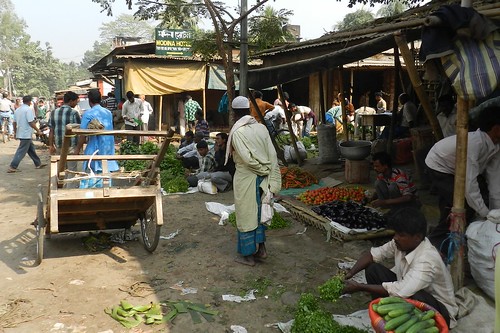
Majority of Muslims in the state are poor and are peasants, or work as daily wage earners, draw rickshaws, work in brick factories, in constructing new buildings, etc.
So from where have these ‘illegal Bangladeshis’ come?
As noted earlier, most of the Bengali speaking Muslims, who migrated to present day Assam from erstwhile East Bengal in the nineteenth and twentieth century, settled in chars or river basins. They are one of the most deprived people, often cut off from the mainland. As mentioned earlier, most of them settled here to work in farmlands or tea farms, and now also work as daily wage earners, at times manual scavengers.
Even the government has now accepted, after several studies, that the land erosion has gobbled 4000 sq km of land, thus engulfing about 2500 villages, according to one estimate. Over 5 million populations have been internally displaced according to these estimates.
The extremely deprived char populace becomes more vulnerable during monsoon season, when people from several chars hurdle in camps, particularly during floods. With few options left, this population is now forced to move towards other settlements in search of better economic opportunities. Many of them come from Dhubri, Barpeta, Kokrajhar, etc. Thus increasingly we see so many ‘Bangladeshis’ pulling rickshaws or working in brick factories or building houses in cities. Thus most of the ‘genuine’ citizens are often labeled as ‘Bangladeshis’ with little proofs. Again let’s not forget most of these people are very poor and illiterate and may always not have required documents in hand.
These (Assamised) Bengali speaking Muslims, although often speak Asamese in public, they can still be easily recognised from their dresses, looks, language, etc. Another interesting point to mention here is that it’s poor Bengali Muslims, who often face the brunt of these oppressions, as educated Muslims are more easily assimilated in crowd.

The media here plays the diabolical role in this kind of myth-making as they will highlight when some rickshaw pullers or labourers are arrested allegedly for illegally entering India, but the response would not get that prominence when eventually they prove their citizenry and produce the required documents.
For example in the month of November, a large group of labourers who were going for work were taken out of bus, beaten and handed over to police as they were suspected to be ‘Bangladeshis.’ They were ‘deproted’ to their respective districts, where all of them eventually produced documents supporting their citizenships.
The crony nexus between extremist groups and local businessmen have also been found to be behind what a local civil rights advocate Mokhlesur Rahman called “manipulated accusations” of being foreign nationals. He also explained how local daily wage labourers are hired by local contractors, but later thrown on accusations of being foreign nationals.
“Local sub-contractors generally pay a month salary in advance and take them to work in say brick factories in Barpeta (or such places). Labourers don’t get money daily, but collect only when they are coming home. Now suppose after three-four months the contractor is required to pay money in bulk, invariably some Bodo groups or AASU (All Assam Students Union) will reach the spot and raise the slogan against ‘Bangladeshi’ workers,” he says.
Although the Muslim population in the whole of Bodoland Territorial Area District (BTAD) is estimated to be about 2.3 lakhs (2011 religion based census data is not out yet), AIUDF leader Badruddin Ajmal gave Bodo supporters meat by declaring that over four lakhs Muslims are forced to suffer in several camps.
First, there was no conclusive head count to validate what a particular politician had said, although largely estimated. Moreover, in panic people from neighboring districts like Barpeta and Bongaigaon too had run away to safer places.
Another reason for such inflated figure might have been that these misery struck people, most of whom are severely deprived often falsely register more names as members of families to get ‘more’ relief materials, particularly rations. This reporter met few such persons, who accepted to have registered names of his family members at least at eight five or more places.
Thus what is often believed to be illegal migration are actually those migrants who came legally to different districts when India and Bangladesh was one country and today might be moving to different districts within the state or outside in search for better opportunities.
The decadal growth in most of these districts is now falling down. But the sharp rise in Muslim populations in last hundred years has often been attributed to illiteracy and backwardness. This was an argument that I heard from almost everyone in the state, academicians, civil rights advocates, etc. A local journalist elaborated more: In villages poor families with little education get their daughters married at the age of 15 or 16, sometimes even less. A year or so they become mother and so in next 15-16 year if the child is girl she is ready to be married. In cities often girls get married after 25 or so and become mother late. By the time a family an average family in catties complete one cycle, a Muslim family in village may have two. Moreover, they are likely to have more babies.
In fact this was what current Assam CM said during an interview to a national TV channel. A senior Guwahati University Political Science Professor Monirul Hussain too argued the same. When I confronted him saying are you echoing Tarun Gagaoi, he quipped “I have been writing and saying this for long and CM is not saying anything new.”
So is it simply ‘the myth of Bangladeshi’?
This is not to deny that there isn’t any migration – legal or illegal for migration is a ‘natural’ process. But certainly it is not of the proportion that it is made out to be. Moreover, during partition and later many Bengali speaking Hindus too migrated from a ‘Muslim Pakistan.’ In the current vitriolic – often one sided – debate over aboriginal vs foreigner issue, its Bengali Muslims who bear the brunt of the attack.
Kokrajhar and Chirang were two most affected district in the July ethnic riot. In Kokrajahr, Gosaigaon subdivision was one of the most affected areas. This reporter, with the help of local groups randomly visited at least 10 villages in this sub-division and found that most affected families had either of the two documents to prove their citizenships – National Residence Certificate (NRC) in the name of head of family (father, grandfather, or in-law) issued by the Government of India in 1951, or name of father, grandfather, or in-laws in voters’ list of 1966 or 1970, or both. As mentioned earlier, the Assam Accord puts March 24, 1971 as the ‘cut off day’ and those who came earlier than that day or their successors are considered citizens of India. Further they also had ration cards and several other documents. Everyone may not have patta (revenue document) of land over which their house is built, as mandated by BTAD for first round of rehabilitation. . In many cases they were found to have documents of neighboruing district of Dhubri, or erstwhile Goalpara. Thus even if there are ‘illegal’ migrants, at least most of those affected or most of those who have to suffer are genuine citizens.
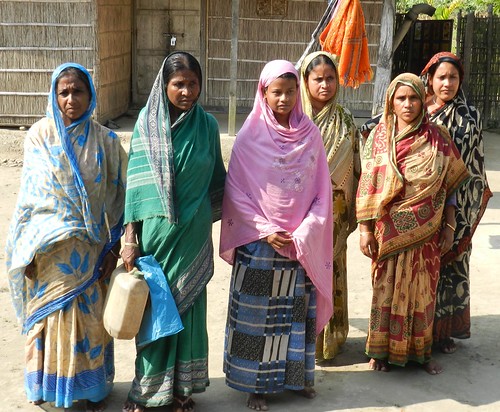
Women often have to suffer the most. When riots broke villagers walked for safer places, sometimes over 20 km or more.
Another ill-fetched argument often given is that ‘illegal migrants’ from Bangladesh are given asylum by Bengali speaking Muslims, who are already living here. Again, there has been little evidence produced except ‘lopsided’ rise in numbers of Muslims. Prof. Monirul Hussain from Gauhati University, as also Prof. Shamsul haque from Gosaigaon, counters that. They argue that that in a region already devoid of much resources, litigations over land and property among brothers and relatives are commonplace; how and why would they invite someone from foreign country to share the limited resources available. Prof. Hussain adds, “It would be very foolish to assume that people migrating from Bangladesh do not know what is happening in India for last 20 years or so, and what has happened to the people of East Bengal origins here in last 20 years or so, beginning with the 1983 Nellie massacres.” Moreover, for over a decade now the economy of Bangladesh is doing well and their human development index is better than many states in India he points out, why would they come here, he asks.
Moreover, those who raise the ‘bogey of Bangladeshi’ forget that these Muslims dominated district and people had consciously decided to stay with India, rather than moving to a ‘Muslim Pakistan.’ Further, having decided to stay in India, they consciously tried to integrate with the local population, regarding Assamese as their official ‘mother tongue.’ For example, in Dhubri with over 74% Muslim population, 70.07% regard Assamese as ‘mother tongue.’ Although most of them speak in Bengali at home, they adapted to Assamese language and culture.
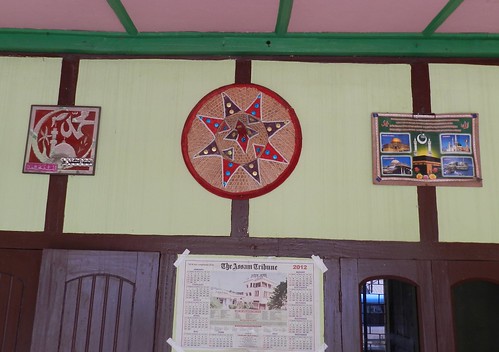
In the courtyard of a Muslim household, traditional japi between frames of names of Allah and Prophet.
Bihu is celebrated in different forms even among Bengali Muslims. Almost everywhere this reporter went, from Guwahati to Nagaon to ‘Muslim’ belt in Gosaigaon subdivision tamul-pan (betel nuts and betel leaves) considered ‘sign of welcome and thanks’ in Assamese culture was offered to him. Japi, traditional Assamese headgear is a piece of decoration now in Assamese home as much as among Bengali Muslims. Multipurpose typical red bordered white Assamese Gamocha too has as much become part of these Bengalis, as coloured lungi has.
Moreover, although earlier they Bengali Hindus too had to face the brunt, to some degrees, today in all this talk of deshi vs vdieshi (citizens vs foreigners) migration of Bengali Hindus are conveniently ignored. In the light of all this, the Bangladeshi bogey that Bengali speaking Muslims in the state have to face is misplaced or in the words of Nilim Dutta, “the contention that Muslim migration is behind the violence in Assam is prejudiced.”
http://twocircles.net/2013jan04/where_have_all_%E2%80%98bangaldeshis%E2%80%99_come_brief_history_muslims_assam.html
